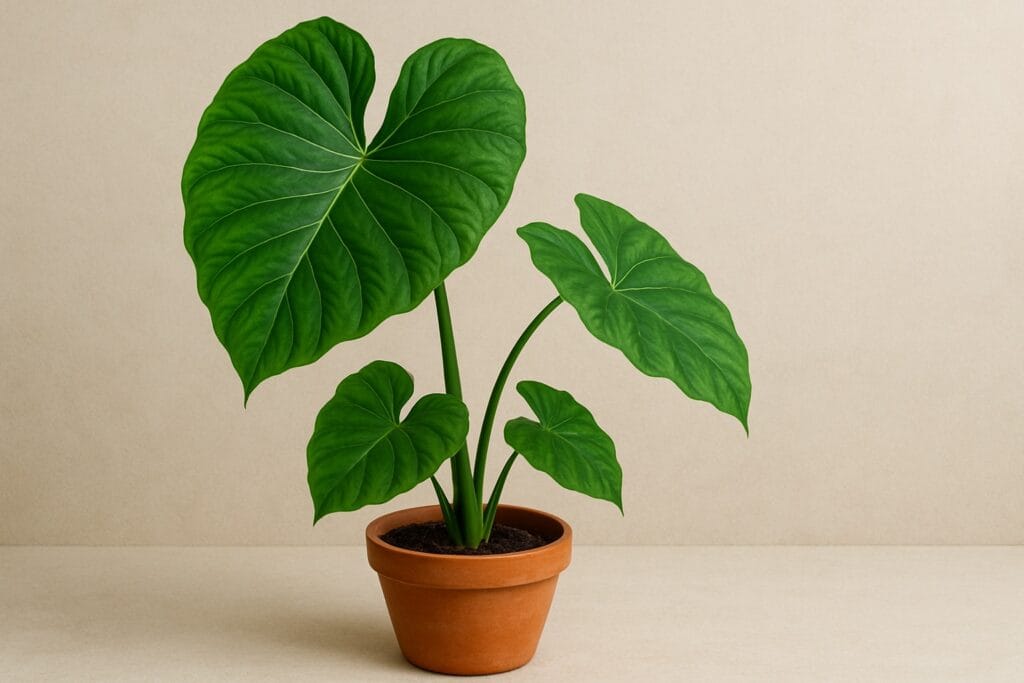How to Care for Elephant Ear Plant: Complete Guide
Introduction
| Feature | Details |
| Common Name | Elephant Ear |
| Scientific Name | Colocasia, Alocasia, Xanthosoma (depends on variety) |
| Plant Type | Tropical perennial (annual in colder zones) |
| Lighting | Bright, indirect sunlight; partial shade outdoors |
| Watering | Keep soil consistently moist, avoid drying out |
| Soil Type | Rich, organic, well-draining soil |
| Temperature | Warm (65-85°F); protect from cold drafts |
| Humidity | High humidity preferred, especially indoors |
| Fertilizing | Monthly during growing season with balanced fertilizer |
| Toxicity | Toxic to pets and humans if ingested |
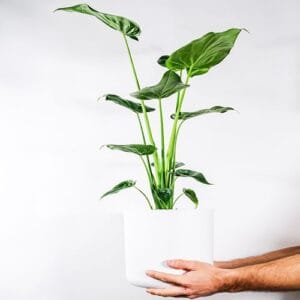
Types of Elephant Ear Plants
There are several popular types of Elephant Ear plants, each with its unique charm:
- Colocasia: Known for heart-shaped leaves that point downward. Commonly called Taro, often grown in wet areas.
- Alocasia: Arrow-shaped leaves that typically point upwards, with striking vein patterns.
- Xanthosoma: Larger, arrow-shaped leaves with a tropical vibe, commonly used in landscaping.
- Caladium: Smaller varieties with colorful, variegated leaves ideal for indoor pots.
Each type has similar care needs with slight variations in light, water, and temperature preferences.
How to Plant Elephant Ear Plants
Choosing the Right Location
- Outdoor Gardens: Choose a spot with partial shade to full sun (depending on variety).
- Indoors: Place near east or north-facing windows for indirect sunlight.
- Soil: Rich, fertile, and well-draining soil is crucial. You can amend the soil with compost or organic matter.
How to Plant Elephant Ear Bulbs
- Timing: Best planted in spring after the last frost.
- Depth: Plant bulbs 2-4 inches deep, with the pointy side up.
- Spacing: Space plants 2-4 feet apart to allow room for large leaves.
- Watering After Planting: Water thoroughly after planting to encourage quick root growth.
How to Water Elephant Ear Plants
Elephant Ears love water but hate soggy roots. Here’s how to water properly:
- Frequency: Water 2-3 times a week during hot months.
- Consistency: Keep the soil evenly moist, especially during the growing season (spring to fall).
- Indoor Tip: Use a moisture meter or stick your finger in the soil—water when the top 2 inches feel dry.
- Avoid: Waterlogging, which can cause root rot.
Benefits of Growing Elephant Ear Plants
- Tropical Aesthetic: Adds an exotic look to gardens and homes.
- Indoor Versatility: Thrives in containers, making it a flexible décor option.
- Wildlife Friendly: Attracts butterflies and provides shade for small garden creatures.
- Air Purification: Like many plants, Elephant Ears contribute to cleaner air.
- Low Maintenance: Once established, they require minimal fuss.
- Variety: With many types and colors, you can find the perfect fit for your space.

Light
Elephant Ear plants thrive best in bright, indirect sunlight. Outdoors, they prefer partial shade, especially during the hottest parts of the day, to prevent leaf scorching. In cooler regions, they can tolerate more direct sunlight, which encourages lush growth. Indoors, place your Elephant Ear near a bright window where it gets filtered light, such as an east or north-facing window. Avoid prolonged direct sunlight indoors, as it can cause the leaves to burn. Proper light balance ensures healthy, large, and vibrant foliage. If leaves appear pale or leggy, it’s a sign they need more light. Rotate indoor pots regularly for even growth.
Temperature and Humidity
Elephant Ear plants thrive in warm, tropical conditions and prefer temperatures between 65°F to 85°F (18°C to 29°C). They are sensitive to cold and should be protected from temperatures below 50°F (10°C). During winter, outdoor plants should be brought inside or their tubers stored indoors in colder regions. Humidity plays a crucial role in their health; these plants love high humidity levels. Dry air can cause brown leaf edges, especially indoors. To maintain humidity, you can mist the leaves regularly, use a humidifier, or place a pebble tray with water beneath the pot. Consistent warmth and moisture ensure lush, vibrant growth.
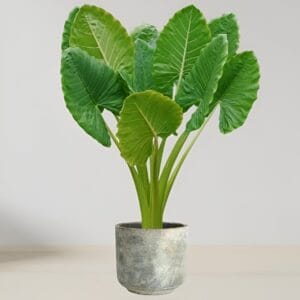
Fertilizing
Elephant Ear plants are heavy feeders and thrive when provided with regular nutrition. During the active growing season (spring through summer), feed your plant once a month using a balanced, water-soluble fertilizer (such as 10-10-10) to encourage large, lush foliage. For even better leaf development, you can opt for a fertilizer slightly higher in nitrogen. Always follow the package instructions to avoid over-fertilization, which can cause leaf burn. In the fall and winter, when the plant enters dormancy, stop fertilizing completely. Regular feeding ensures your Elephant Ear plant remains healthy, vibrant, and produces those iconic, giant leaves you love.
Pruning & Maintenance
Proper pruning and maintenance are key to keeping your Elephant Ear plants healthy, vibrant, and beautiful. Regularly pruning helps remove dead or damaged leaves, allowing the plant to focus energy on new growth. Always use clean, sharp pruning shears to trim leaves at the base of the stem, especially if they turn yellow or brown. This not only improves the plant’s appearance but also prevents the spread of disease.
During the growing season, occasional pruning keeps the plant tidy and encourages larger, healthier leaves. For outdoor plants, cut back all foliage after the first frost to prepare the plant for winter. If grown in pots indoors, remove older leaves as needed to manage size and appearance.
Maintenance also involves checking for pests like aphids or spider mites, wiping leaves clean of dust, and rotating pots for even sunlight exposure. With simple care routines, Elephant Ear plants thrive and remain a showstopper in your home or garden.
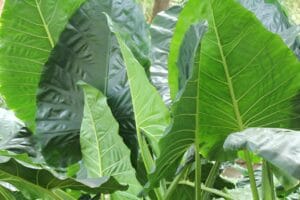
Common Problems and Solutions
| Problem | Cause | Solution |
| Yellow Leaves | Overwatering or too much direct sunlight | Adjust watering, provide partial shade |
| Brown Leaf Edges | Low humidity | Increase humidity or mist leaves |
| Stunted Growth | Lack of nutrients | Use a balanced fertilizer |
| Drooping Leaves | Underwatering or cold shock | Water regularly, avoid cold drafts |
| Pests | Aphids, mites | Wipe leaves, use neem oil |
Elephant Ear Winter Care Tips
- Dig up bulbs before first frost if outdoors.
- Let tubers dry for a day, store in peat moss or sawdust in a cool, dark place.
- Indoor plants can stay in pots but reduce watering to prevent rot.
- In spring, replant bulbs or resume watering to wake up indoor plants.
How to Propagate Elephant Ear Plants
Propagation is easy and rewarding!
Methods:
- By Bulbs/Tubers:
- During winter storage, you may notice smaller tubers—these can be planted separately in spring.
- During winter storage, you may notice smaller tubers—these can be planted separately in spring.
- By Division:
- Dig up mature plants and gently separate offsets or tubers.
- Dig up mature plants and gently separate offsets or tubers.
- Steps:
- Use clean, sharp tools.
- Plant new tubers in fresh soil.
- Water and place in warm, bright conditions.
- Use clean, sharp tools.
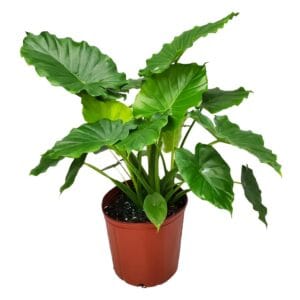
Indoor vs Outdoor Elephant Ear Care
| Aspect | Indoor | Outdoor |
| Light | Bright, indirect | Partial shade/full sun |
| Watering | Moderate | Frequent |
| Winter Care | Reduce water, no frost issues | Dig up bulbs in cold regions |
| Size | Smaller, manageable | Can grow up to 6 ft tall |
FAQs About Elephant Ear Plants
1. Are Elephant Ear plants easy to care for?
Yes! With adequate water, light, and fertilizer, they thrive indoors or outdoors with minimal care.
2. Do Elephant Ear plants come back every year?
In warm climates (zones 8-11), they are perennials. In colder areas, you can overwinter bulbs indoors.
3. How fast do Elephant Ears grow?
Very fast—expect substantial growth within one season when properly cared for.
4. Are Elephant Ear plants toxic?
Yes, they are toxic if ingested. Keep away from pets and children.
5. Can Elephant Ears grow in pots?
Absolutely! Choose large containers, provide drainage, and ensure they get enough light.
Conclusion
Elephant Ear plants are a stunning addition to any space, offering large, tropical leaves that can transform your home or garden. While their dramatic appearance may seem intimidating, these plants are surprisingly easy to grow with proper care. From selecting the right variety to learning the perfect watering routine, anyone can enjoy these tropical beauties.

